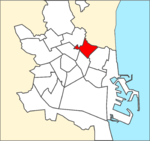Del Real Palace, Valencia

The now vanished Del Real Palace or Royal Palace (in Valencian, Palau del Real; in Spanish, Palacio del Real) was the former residence of the kings of Valencia in the «Cap i Casal» (head and home) of the Kingdom, as the city of Valencia was then called. It was on the left bank of the Turia River, where nowadays Jardines del Real are. It was also known as «300 keys palace» in reference to the number of rooms it had in its heights. From 11th to 19th centuries it was royal seat whether for the kings of the Taifa of Valencia or the monarchs of the Crown of Aragon, the Habsburgs and the Bourbons, while it was less appreciated by the latter. Late-19th century Valencian political Teodoro Llorente quotes "What happened to you, Palacio del Real? noble mansion of the Valencian monarchs, centre and symbol of our ancient and glorious kingdom (...) All disappeared with the institutions that you represented, the illustrious autonomy of that kingdom that you were head..."
Excerpt from the Wikipedia article Del Real Palace, Valencia (License: CC BY-SA 3.0, Authors, Images).Del Real Palace, Valencia
Passeig d'Antonio Machado, Valencia la Saïdia
Geographical coordinates (GPS) Address Nearby Places Show on map
Geographical coordinates (GPS)
| Latitude | Longitude |
|---|---|
| N 39.48 ° | E -0.368 ° |
Address
Passeig d'Antonio Machado
Passeig d'Antonio Machado
46010 Valencia, la Saïdia
Valencian Community, Spain
Open on Google Maps











